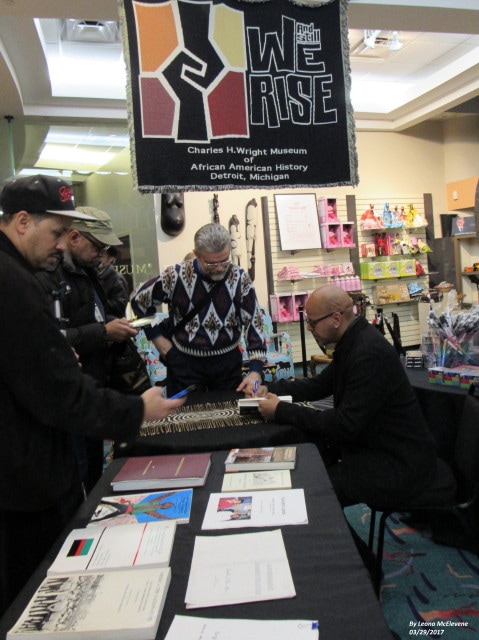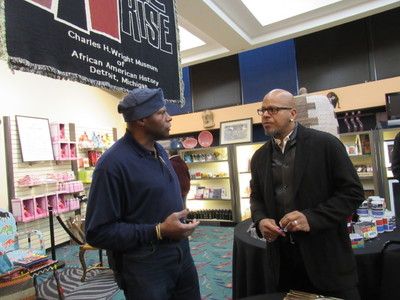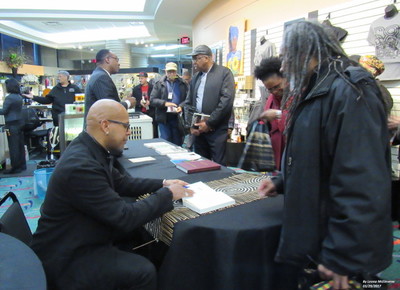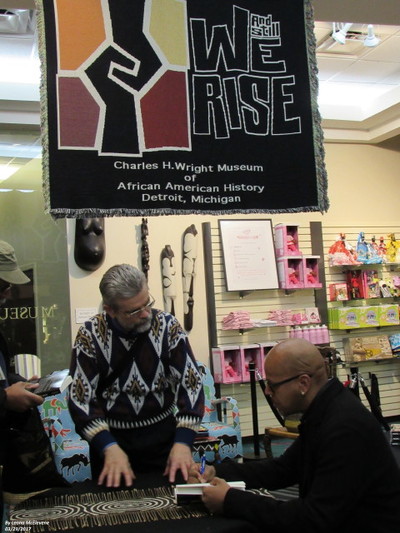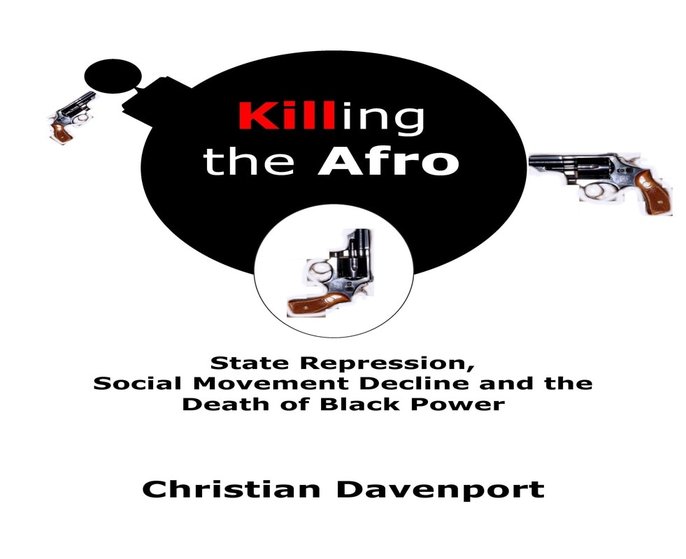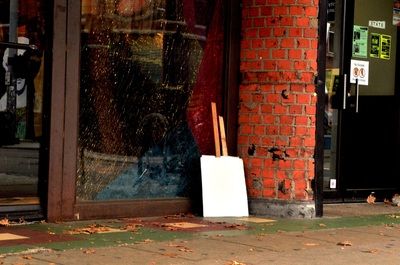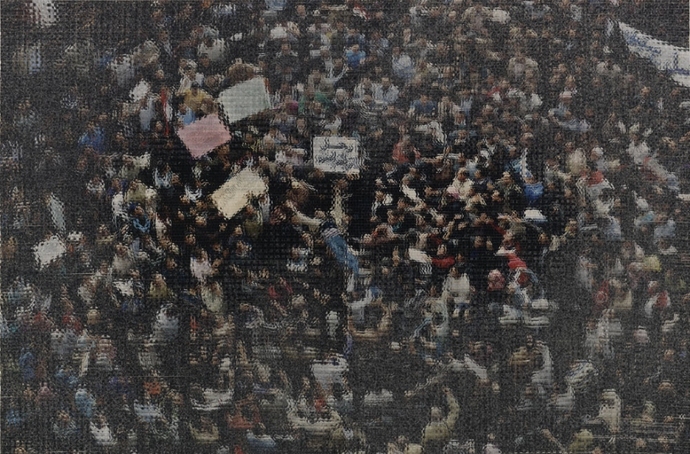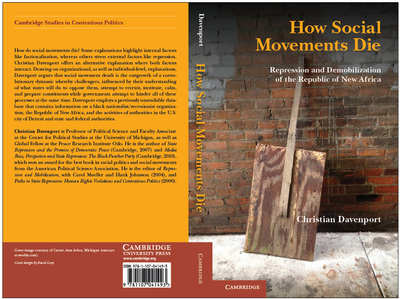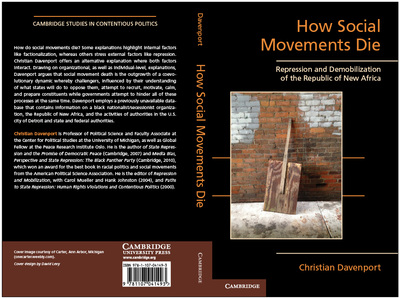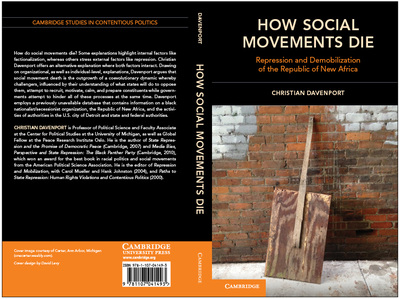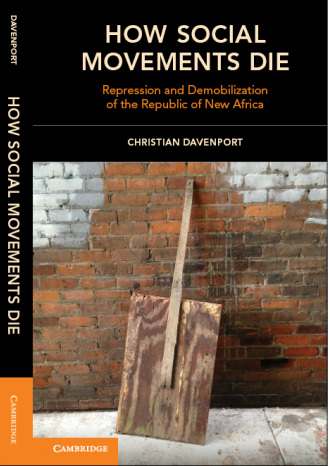
How Social Movements Die: Repression and Demobilization of the Republic of New Africa
INtro: For those that know me, they know that I refer to this book by the title "To Kill a Movement." This is the title that I used for years as I was thinking about and then working on the project. The publisher did not like it though, so there you go.
Overview: Conventionally researchers, policymakers, activists and general observers have suggested that social movements are killed either from the "outside" (e.g., from repression) or the "inside" (e.g., from activist burnout or fractionalization). This book explores how these two factors interact, noting that governments and challengers co-evolve with the one responding (or not) to the actions taken by the other. From my argument, challengers that lag in their response, respond in an inappropriate manner or develop bad habits which weaken the organization die. Those who stay up on their responsivity, respond in an appropriate manner to the threats they are confronted with and develop good habits survive. Governments have a certain advantage in this dynamic process (an ace in the hole, so to speak): not all that are in social movements are actually working with/for social movements themselves. Inside information (informants) and subversion (agents provocateur) facilitates effective government repressive action and organizational deterioration. To investigate this topic I use a very disaggregated and detailed analysis of a black nationalist organization (The Republic of New Africa) as well as diverse political authorities that sought to disrupt and destroy the organization (the FBI, Michigan State Police and the Detroit Police Department). The time period of interest is 1968 (the founding of the organization) to 1973 (when the original cohort is no longer engaged).
Contents
Introduction
Part I – Theory
1. Killing Social Movements from the Outside or the Inside
2. Killing Social Movements from the Outside and the Inside
Part II – Case
3. Repression and Red Squads
4. Record Keeping and Data Collection
Part III – Origins
5. We Shall Overcome? From GOAL to the Freedom Now Party
6. We Shall Overthrow! From the Malcolm X Society to the Republic of New Africa
Part IV – Examination
7. Birth of a Black Nation
8. To Ocean Hill-Brownsville and B(l)ack
9. New Bethel and the End of the Beginning
10. When Separatists Separate
11. Mississippi: The Last Stand(off)
Part V – Conclusion
12. Understanding the Death of Social Movement Organizations
Review Excerpts & Full Reviews
Review in Perspectives on Politics (2017) - "How Social Movements Die ... represents a new scholarly foundation from which to build. Scholars of contentious politics can use the ideas presented here to develop operational definitions that can be applied to other SMOs and other countries. Others can dig into particular aspects of the complex framework to consider the strategic logic of the feedback loops. The particular focus on organizations and their internal dynamics, combined with the essential pairing of external and internal forces affecting social movements, is illuminating and frame shifting in studies of political violence, particularly in political science. This book should be considered essential reading for students of political violence in particular and political contention more broadly."
Review in Contemporary Sociology (2016) - "Christian Davenport’s How Social Movements Die offers an excellent analysis of movement demobilization"... "This study contributes to our understanding of collective action, not only by providing new insights and findings on movement demobi- lization, but also by opening up a novel area of research necessary to fully understand the dynamics of social movements."
Review in American Journal of Sociology (2016) - "There is a great deal to admire about this book—from its astonishingly rich data and thorough analysis to its clear theorizing about an important and nettlesome issue in the study of repression (What are the consequences of repression?) to its call for research on demobilization".... "a must read"
Review in Social Forces (2015) - "Impressive"
Review in Mobilization (2014) - "theoretically-informative and conceptually-rich"... "The book comes highly recommended"
Review in Mobilization (2015) - "Certainly, How Social Movements Die will be a provocative read on an understudied movement for subscribers and contributors to this journal, many of whom are cited in the book. The pacing will make it a bit challenging for classroom adoption, but it should become an outstanding resource for discussion of methodological strategies in studying contention—particularly given Davenport’s argument for using documents (even those from hostile organizations) over retrospective interviews. The result of a legalistic movement intersecting with a highly refined government surveillance bureaucracy, the RNA yielded “a perfect storm of data release and dis- covery (i.e., lawsuits, hoarding, and systematic archiving)” (p. 13). Chapter 4, Record Keeping and Data Collection, is an absolutely fascinating—and bracing—read in the post-Snowden, “big data” era."
Book Blurbs
"Marshalling insightful analysis, brilliant archival research, and extensive knowledge, Davenport explains the emergence, growth, and demise of social movements. This book is a real gem."
-- Scott Gates, Peace Research Institute Oslo and Norwegian University of Science and Technology
"Christian Davenport presents us with new theoretical insights into the external forces and internal dynamics that can eventually lead to the demise of a social movement organization that at its inception was at the forefront of a broader movement. His analysis of archival information on both overt and covert forms of state repression as well as his scrupulous analysis of RNA internal documents present us with innovative methods and novel lessons for the study of how social movement organizations emerge and eventually die."
-- T. David Mason, University of North Texas
"Christian Davenport brings his expertise on political repression to bear on a question that has, oddly, been largely neglected by scholars: how and why do social movements die? Drawing on unusually rich data that take us inside the thought processes of movement actors as well as their opponents, Davenport offers deep insight into both the rise and demise of social movement organizations."
-- Rory McVeigh, University of Notre Dame
- Cambridge University Press, Cambridge Studies in Contentious Politics (2015)
INtro: For those that know me, they know that I refer to this book by the title "To Kill a Movement." This is the title that I used for years as I was thinking about and then working on the project. The publisher did not like it though, so there you go.
Overview: Conventionally researchers, policymakers, activists and general observers have suggested that social movements are killed either from the "outside" (e.g., from repression) or the "inside" (e.g., from activist burnout or fractionalization). This book explores how these two factors interact, noting that governments and challengers co-evolve with the one responding (or not) to the actions taken by the other. From my argument, challengers that lag in their response, respond in an inappropriate manner or develop bad habits which weaken the organization die. Those who stay up on their responsivity, respond in an appropriate manner to the threats they are confronted with and develop good habits survive. Governments have a certain advantage in this dynamic process (an ace in the hole, so to speak): not all that are in social movements are actually working with/for social movements themselves. Inside information (informants) and subversion (agents provocateur) facilitates effective government repressive action and organizational deterioration. To investigate this topic I use a very disaggregated and detailed analysis of a black nationalist organization (The Republic of New Africa) as well as diverse political authorities that sought to disrupt and destroy the organization (the FBI, Michigan State Police and the Detroit Police Department). The time period of interest is 1968 (the founding of the organization) to 1973 (when the original cohort is no longer engaged).
Contents
Introduction
Part I – Theory
1. Killing Social Movements from the Outside or the Inside
2. Killing Social Movements from the Outside and the Inside
Part II – Case
3. Repression and Red Squads
4. Record Keeping and Data Collection
Part III – Origins
5. We Shall Overcome? From GOAL to the Freedom Now Party
6. We Shall Overthrow! From the Malcolm X Society to the Republic of New Africa
Part IV – Examination
7. Birth of a Black Nation
8. To Ocean Hill-Brownsville and B(l)ack
9. New Bethel and the End of the Beginning
10. When Separatists Separate
11. Mississippi: The Last Stand(off)
Part V – Conclusion
12. Understanding the Death of Social Movement Organizations
Review Excerpts & Full Reviews
Review in Perspectives on Politics (2017) - "How Social Movements Die ... represents a new scholarly foundation from which to build. Scholars of contentious politics can use the ideas presented here to develop operational definitions that can be applied to other SMOs and other countries. Others can dig into particular aspects of the complex framework to consider the strategic logic of the feedback loops. The particular focus on organizations and their internal dynamics, combined with the essential pairing of external and internal forces affecting social movements, is illuminating and frame shifting in studies of political violence, particularly in political science. This book should be considered essential reading for students of political violence in particular and political contention more broadly."
Review in Contemporary Sociology (2016) - "Christian Davenport’s How Social Movements Die offers an excellent analysis of movement demobilization"... "This study contributes to our understanding of collective action, not only by providing new insights and findings on movement demobi- lization, but also by opening up a novel area of research necessary to fully understand the dynamics of social movements."
Review in American Journal of Sociology (2016) - "There is a great deal to admire about this book—from its astonishingly rich data and thorough analysis to its clear theorizing about an important and nettlesome issue in the study of repression (What are the consequences of repression?) to its call for research on demobilization".... "a must read"
Review in Social Forces (2015) - "Impressive"
Review in Mobilization (2014) - "theoretically-informative and conceptually-rich"... "The book comes highly recommended"
Review in Mobilization (2015) - "Certainly, How Social Movements Die will be a provocative read on an understudied movement for subscribers and contributors to this journal, many of whom are cited in the book. The pacing will make it a bit challenging for classroom adoption, but it should become an outstanding resource for discussion of methodological strategies in studying contention—particularly given Davenport’s argument for using documents (even those from hostile organizations) over retrospective interviews. The result of a legalistic movement intersecting with a highly refined government surveillance bureaucracy, the RNA yielded “a perfect storm of data release and dis- covery (i.e., lawsuits, hoarding, and systematic archiving)” (p. 13). Chapter 4, Record Keeping and Data Collection, is an absolutely fascinating—and bracing—read in the post-Snowden, “big data” era."
Book Blurbs
"Marshalling insightful analysis, brilliant archival research, and extensive knowledge, Davenport explains the emergence, growth, and demise of social movements. This book is a real gem."
-- Scott Gates, Peace Research Institute Oslo and Norwegian University of Science and Technology
"Christian Davenport presents us with new theoretical insights into the external forces and internal dynamics that can eventually lead to the demise of a social movement organization that at its inception was at the forefront of a broader movement. His analysis of archival information on both overt and covert forms of state repression as well as his scrupulous analysis of RNA internal documents present us with innovative methods and novel lessons for the study of how social movement organizations emerge and eventually die."
-- T. David Mason, University of North Texas
"Christian Davenport brings his expertise on political repression to bear on a question that has, oddly, been largely neglected by scholars: how and why do social movements die? Drawing on unusually rich data that take us inside the thought processes of movement actors as well as their opponents, Davenport offers deep insight into both the rise and demise of social movement organizations."
-- Rory McVeigh, University of Notre Dame
Book Signing
Alternative Titles and Covers
Initially, I was not sure what the title was going to be or the cover art as I went back and forth with the publisher. Below is the image that I came up with. I liked the idea of the title and the image (especially the little gun pointed at the afro comb/pick) but it immediately prompted one to think that the book was exclusively about African Americans which it was not. This is where my case comes from but this does not constitute the full range of cases that I believe the work was applicable to. This tension is a broader one about case selection and the ability of the reading audience to see African American anything as an example that can be viewed as comparable to anyone else. Invariably, I moved away from the title. I will write more about this process later.
As an alternative cover image, I wanted to find something that was a bit more abstracted but that communicated something relevant to social movement organizations. I had three artist friends take a shot.
Below are three photographs from my friend Scott Carter. I like the symbolic nature of the upside down picket sign akin to the upside down cross transforming the meaning of the rightside up object.
Another friend Hilary Nichols had a very different take on the same theme.
The last possibility is something created by my (older) friend John Sparagana. I love the blurring effect as one moves further from the center. The idea would be to have this continue to blur until it disappears.
Cambridge liked Carter's take.
Below are three photographs from my friend Scott Carter. I like the symbolic nature of the upside down picket sign akin to the upside down cross transforming the meaning of the rightside up object.
Another friend Hilary Nichols had a very different take on the same theme.
The last possibility is something created by my (older) friend John Sparagana. I love the blurring effect as one moves further from the center. The idea would be to have this continue to blur until it disappears.
Cambridge liked Carter's take.
(Scott) Carter's Images
Hilary Nichol's Images
John Sparagana's Image
These were the alternative covers.
